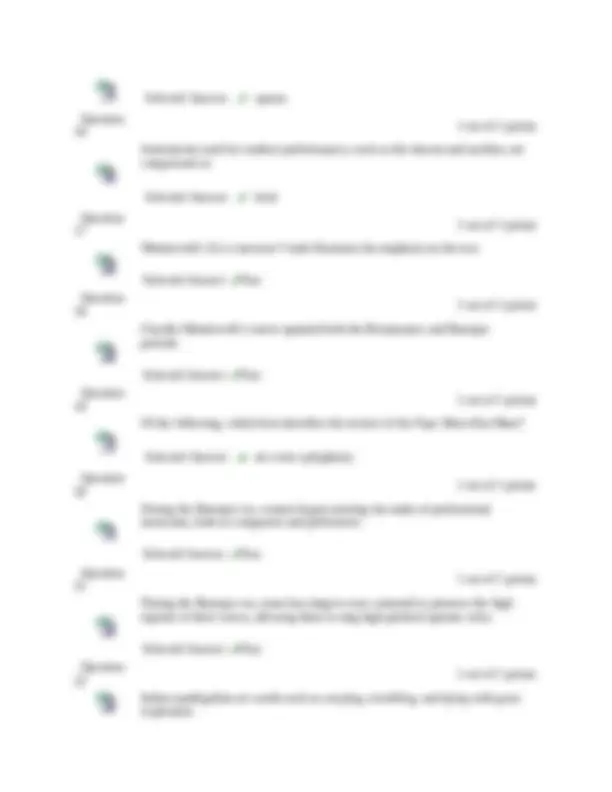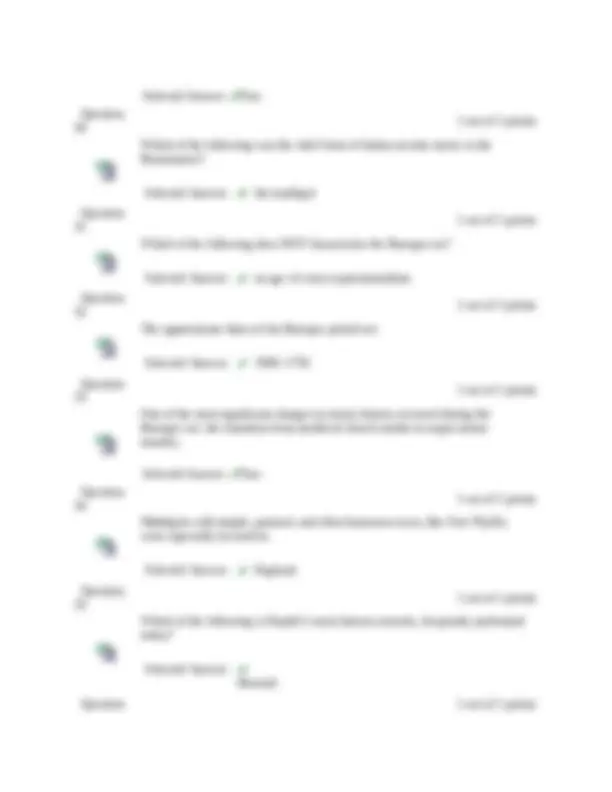






Study with the several resources on Docsity

Earn points by helping other students or get them with a premium plan


Prepare for your exams
Study with the several resources on Docsity

Earn points to download
Earn points by helping other students or get them with a premium plan
Community
Ask the community for help and clear up your study doubts
Discover the best universities in your country according to Docsity users
Free resources
Download our free guides on studying techniques, anxiety management strategies, and thesis advice from Docsity tutors
Material Type: Quiz; Class: Music in the Humanites; Subject: Music; University: Eastern Washington University; Term: Summer 2012;
Typology: Quizzes
1 / 8

This page cannot be seen from the preview
Don't miss anything!





Question 1 1 out of 1 points Which of the following shows the years of the musical Renaissance period? Selected Answer: 1450-1600 AD Question 2 1 out of 1 points The structure known as binary form is: Selected Answer: a-a-b-b. Question 3 1 out of 1 points ____________ was born in Germany and studied in Italy, but spent much of his creative life in England. Selected Answer: Handel Question 4 1 out of 1 points The group of early Baroque writers, artists, and musicians whose aim was to resurrect the musical drama of ancient Greece was known as: Selected Answer: the Florentine Camerata. Question 5 1 out of 1 points The oratorio was a dramatic, staged work with elaborate scenery and costumes. Selected Answer: False Question 6 1 out of 1 points Which best describes how Baroque musicians made a living? Selected Answer: all of the above Question 7 1 out of 1 points During the Baroque period, composers showed an interest in the music of other cultures. Selected Answer: True Question 1 out of 1 points
The vivid depiction of the text through music, known as word painting, is a hallmark of: Selected Answer: the madrigal. Question 9 1 out of 1 points “Rejoice greatly, O daughter of Zion” from Messiah is an example of: Selected Answer: a da capo aria. Question 10 1 out of 1 points In the Baroque era, music always had frequent changes of mood. Selected Answer: False Question 11 1 out of 1 points The sixteenth century saw a blossoming of instrumental dance music. Selected Answer: True Question 12 1 out of 1 points What is the musical basis of Josquin’s Ave Maria... virgo serena? Selected Answer: a Gregorian chant in the top voice, then freely composed Question 13 1 out of 1 points The introduction of monody in music represented a major shift in texture from: Selected Answer: polyphonic to homophonic. Question 14 1 out of 1 points Like the Renaissance motet, the polyphonic setting of the Mass was often based on a cantus firmus. Selected Answer: True Question 15 1 out of 1 points When Handel arrived in London, he established his fame by composing:
Selected Answer: True Question 23 1 out of 1 points Who is the composer of the Pope Marcellus Mass? Selected Answer: Palestrina Question 24 1 out of 1 points One transition from Renaissance to Baroque was characterized by the change from polyphonic to homophonic texture in music. Selected Answer: True Question 25 1 out of 1 points Josquin’s Ave Maria... virgo serena is an example of: Selected Answer: a motet. Question 26 1 out of 1 points During the late sixteenth century, the principal center for polychoral singing was: Selected Answer: St. Mark’s of Venice. Question 27 1 out of 1 points Which early Renaissance composer exerted a powerful influence on generations of composers who followed? Selected Answer: Josquin Question 28 1 out of 1 points Improvisation played little or no part in Baroque musical practice. Selected Answer: False Question 29 1 out of 1 points The upper voice parts of the Pope Marcellus Mass were sung by boy sopranos or adult males with high voices.
Selected Answer: True Question 30 1 out of 1 points Which of the following was the chief form of Italian secular music in the Renaissance? Selected Answer: the madrigal Question 31 1 out of 1 points Which of the following does NOT characterize the Baroque era? Selected Answer: an age of crazy experimentalism Question 32 1 out of 1 points The approximate dates of the Baroque period are: Selected Answer: 1600–1750. Question 33 1 out of 1 points One of the most significant changes in music history occurred during the Baroque era: the transition from medieval church modes to major-minor tonality. Selected Answer: True Question 34 1 out of 1 points Madrigals with simple, pastoral, and often humorous texts, like Fair Phyllis, were especially favored in: Selected Answer: England. Question 35 1 out of 1 points Which of the following is Handel’s most famous oratorio, frequently performed today? Selected Answer: Messiah Question 1 out of 1 points
The term Baroque probably derives from: Selected Answer: a Portuguese word meaning irregular in shape (used to describe pearls). Question 44 1 out of 1 points What is a cantus firmus? Selected Answer: a fragment of Gregorian chant (fixed melody) used as the foundation of a polyphonic Mass Question 45 1 out of 1 points The late Renaissance madrigal was highly expressive through such devices as virtuosic display and chromatic harmony. Selected Answer: True Question 46 1 out of 1 points All of the following characterize Baroque musical style EXCEPT: Selected Answer: harmonies built on the early church modes. Question 47 1 out of 1 points Unlike Italian madrigals, Fair Phyllis has no word painting. Selected Answer: False Question 48 1 out of 1 points Where was the madrigal first developed? Selected Answer: Italy Question 49 1 out of 1 points The Baroque performance practice where musicians embellished the melodies was called: Selected Answer: improvisation. Question 50 1 out of 1 points
Baroque music often features a steady, vigorous beat throughout. Selected Answer: True